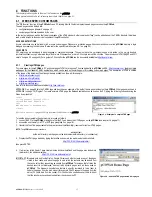
pCOWeb
+030220966 – rel. 1.1 – 12.12.2017
18
4.2
ACCESSING THE USER MEMORY VIA FTP OR SCP
pCOWeb
features FTP and SCP servers that are used to access the user memory and load or retrieve files, for example custom HTML pages, configuration
files, log files. To use this function, the PC should be installed with an FTP or SCP client; for example WinSCP (
https://winscp.net/
) or FileZilla (
https://filezilla-
project.org/
). The latter is used in the following example with FTP protocol (for other software or SCP protocol, the procedure is similar).
Figure 4.c - FileZilla: creating a new “Site Manager”
PROCEDURE
1.
Download, install and run Filezilla on the PC.
2.
Create a new “Site Manager” and enter the data as shown in Figure 4.c and Figure 4.d.
NOTE
The IP address should be replaced with the address of the
pCOWeb
; the default Username and Password are: httpadmin /
f
httpadmin; paragraph 9.8.2 on page 50
describes how to change this information, and paragraph 9.8 on page 49 shows how to read the current information. The following examples assume that the current data
being used are httpadmin / fhttpadmin and the IP address is 10.0.5.0.
Figure 4.d - FileZilla: set a new “Site Manager”
Once having selected the OK button, the contents of the user memory will be displayed
(path usr/local/root/flash/http/); if this is not the case:
3.
check the suggestions shown in chapter 3 on page 11: if the PC cannot access at
least one HTML page on the
pCOWeb
, it will not be able to access via FTP or SCP;
4.
check that the PC is not running a firewall to block unwanted connections; for
example, in Windows XP “Windows Firewall” is normally active, and in the default
configuration this blocks communication; to modify the settings, open the “Control
panel”, select “Windows Firewall” and disable it (Figure 4.e).
IMPORTANT: Some FTP clients do not use the request from
pCOWeb
to open the user
memory for “httpadmin” (/usr/local/root/flash/http/), but rather show the contents of the
root position; the user needs to manually go to /usr/local/root/flash/http/.
Figure 4.e - Disabling Windows Firewall






























